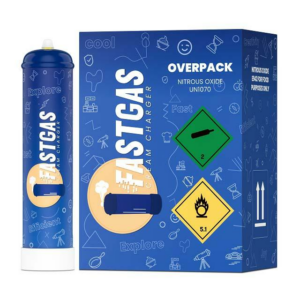Sustainability Matters: The Eco-Friendly Side of Cream Chargers
FastGas Blog
In today’s world, where environmental concerns are more pressing than ever, adopting sustainable practices in all aspects of life has become crucial. Even seemingly small choices can have a significant impact on the planet. This brings us to the intriguing intersection of culinary indulgence and sustainability—the eco-friendly side of cream chargers. Let’s delve into how these little FastGas cream chargers of culinary delight are making big strides toward a greener future.
The Cream Charger Revolution: A Brief Overview
Cream chargers, including FastGas cream chargers, also known as nitrous oxide chargers or N2O cartridges, are the unsung heroes behind the velvety, airy texture of whipped cream that graces our desserts and beverages. These small, pressurized canisters contain nitrous oxide gas, which is used to whip cream and create that delightful foam we all love. While cream chargers have been a kitchen staple for a long time, the focus on sustainability has prompted manufacturers and consumers alike to consider their environmental impact.
The Environmental Challenge
Historically, the environmental impact of cream chargers hasn’t been a significant concern for most people. After all, they’re small and seemingly harmless. However, the reality is that the gas inside these chargers, nitrous oxide (N2O), is a potent greenhouse gas. N2O is known to have a significantly higher global warming potential than carbon dioxide (CO2). When released into the atmosphere, it can contribute to climate change and ozone depletion.
Considering the widespread use of cream chargers in the culinary world, the cumulative effect of their emissions can be substantial. This realization has led to a growing interest in finding more sustainable alternatives.
Eco-Friendly Innovations: The Way Forward
The good news is that the culinary industry, like many others, is not turning a blind eye to sustainability concerns. Several innovative approaches are being explored to reduce the environmental impact of cream chargers while still delivering the same delectable results.
Alternative Propellants
One avenue being explored is the use of alternative propellants that have a lower impact on the environment. For example, some chargers are being designed to use carbon dioxide (CO2) gas instead of nitrous oxide. CO2 has a lower global warming potential and doesn’t contribute to ozone depletion.
Reusable Chargers
Reusable cream chargers are gaining attention as a sustainable option. These chargers can be refilled multiple times, reducing the need for single-use canisters and lowering overall waste. While the initial investment might be higher, the long-term benefits for both the environment and your wallet are substantial.
Embracing the Change: What You Can Do
As consumers, our choices have a significant impact on shaping the direction of the industry. Here are a few ways you can contribute to a more eco-friendly approach to cream chargers:
Reduce Usage
While the allure of perfectly whipped cream is hard to resist, consider reducing the frequency of cream charger use. By indulging in whipped cream occasionally instead of regularly, you can minimize your carbon footprint.
Proper Disposal
If you’re using traditional cream chargers, make sure to properly dispose of the empty canisters. Many companies provide recycling programs specifically for cream chargers. Follow their guidelines to ensure responsible disposal.
Spread Awareness
Share your knowledge about the environmental impact of cream chargers with friends, family, and fellow food enthusiasts. The more people are aware of the issue, the greater the demand for sustainable solutions.
A Greener Culinary Future with FastGas cream chargers
In the quest for a more sustainable future, even seemingly insignificant choices can make a remarkable difference. The eco-friendly side of cream chargers reminds us that innovation and sustainability can coexist, transforming our culinary experiences while preserving the planet we call home. As consumers, we have the power to drive change through our choices. By supporting sustainable options and advocating for greener practices, we can contribute to a more eco-conscious culinary landscape that benefits both our taste buds and the Earth.





